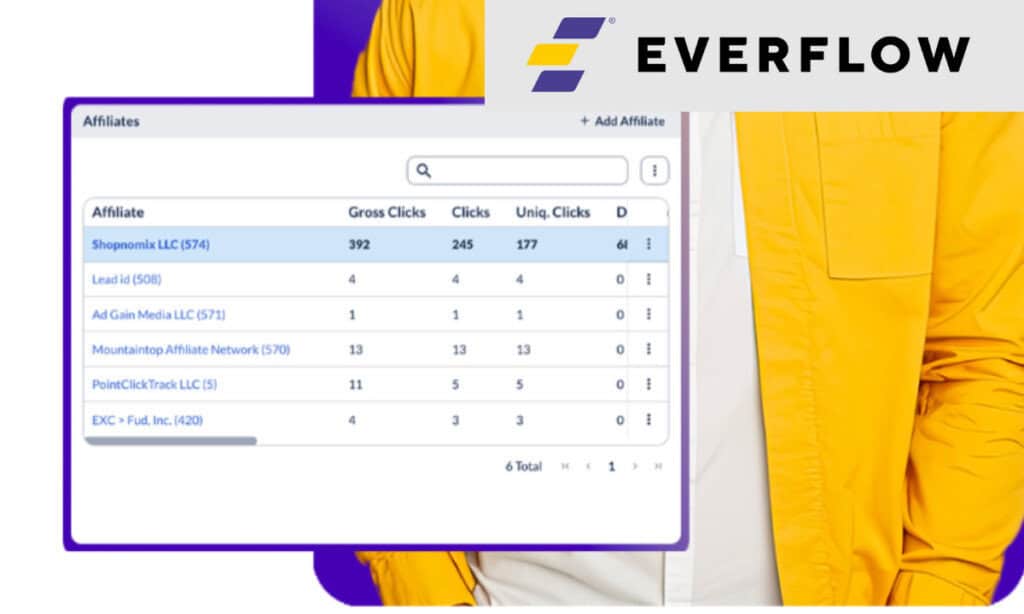- What Is Everflow? (And Who Is It For?)
- First Impressions & Ease of Use
- Key Features of Everflow
- 1. Partner & Affiliate Management
- 2. Offer & Campaign Management
- 3. Tracking & Attribution
- 4. Analytics & Reporting
- 5. Payments
- 6. Integrations & Ecosystem
- How Everflow Compares for Affiliate Programs
- Pricing & Support
- Final Verdict
Last Updated on October 22, 2025 by Ewen Finser
When you’re running an affiliate or partner program, spreadsheets and outdated dashboards can only take you so far. You need clear data, automation that actually works, and a way to see which partners are truly driving revenue.
In 2025, businesses want to get rid of this admin work that eats up valuable time.
That’s exactly what Everflow promises, and after doing a bit of hands-on testing, I can see why so many brands are talking about Everflow.
Let’s go through the platform’s most important features step by step. I’ll share where it shines, where it could improve, and who it’s best for.
What Is Everflow? (And Who Is It For?)
Everflow is an all-in-one affiliate and partner marketing platform used by thousands of top brands, including ClassPass, Golden Hippo, and JG Wentworth. It helps you track and manage everything from affiliate and influencer campaigns to agency media buys and B2B referral programs.
It isn’t a platform like Upfluence, which is mostly for finding and managing influencers. It’s more of an overall marketing dashboard for managing influencers and partners, with deep analytics and tracking to understand it all.
The Everflow Dashboard
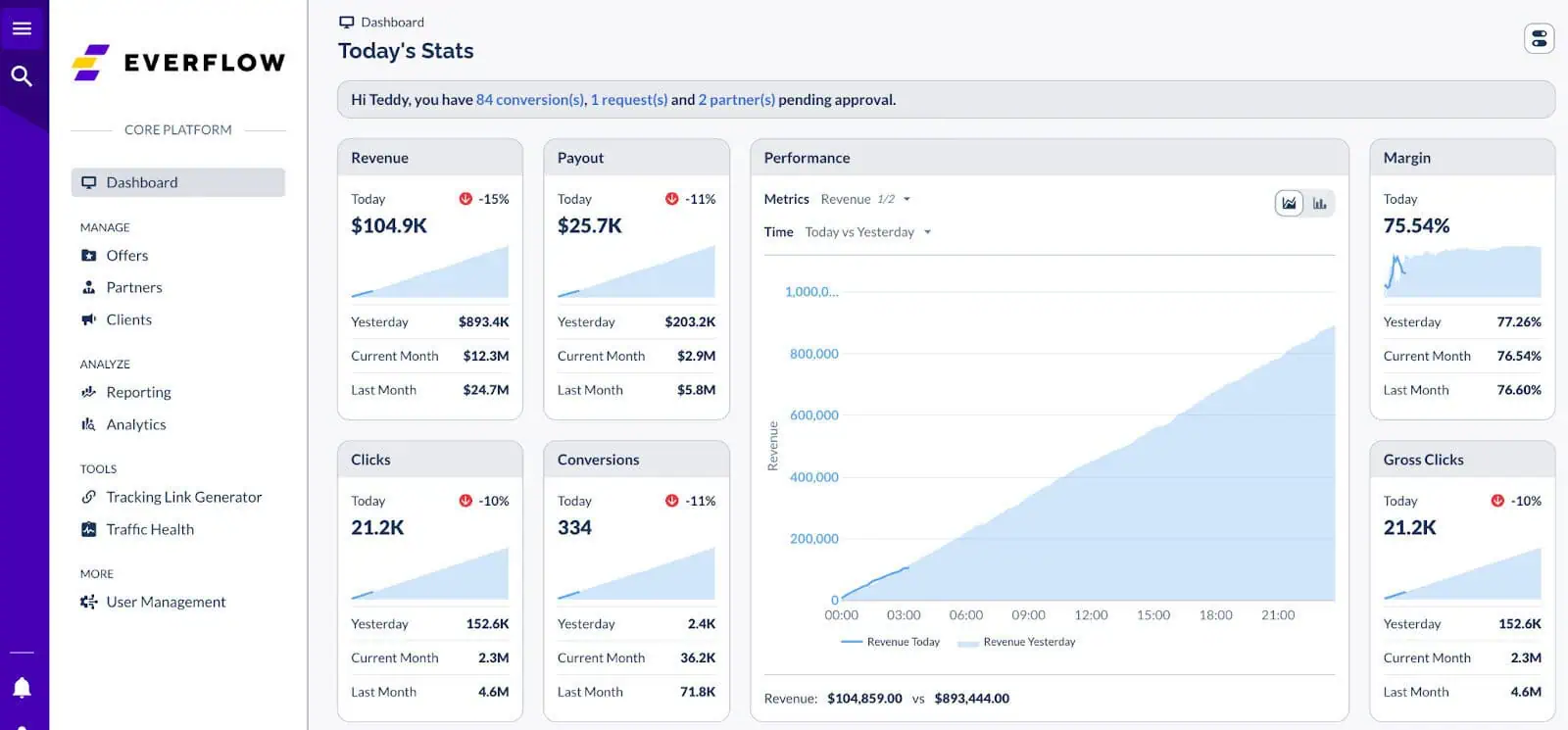
It’s designed for:
- E-commerce brands – track SKU-level performance, influencer campaigns, and coupon usage.
- SaaS companies – attribute signups, free trials, upgrades, and renewals.
- Agencies – manage multiple client programs in one dashboard.
- B2B and performance marketers – track referrals, partner deals, and CRM events.
It also has a “curated marketplace” to help brands find great affiliate partners and publications without having to sift through millions of unnecessary profiles.
One thing that makes it stand out from the main competition is it allows you to track Google and Facebook traffic, plus paid posts from outside Everflow. This means it gives you a perfect view of all your marketing activities in one place, so it’s easy to track your performance.
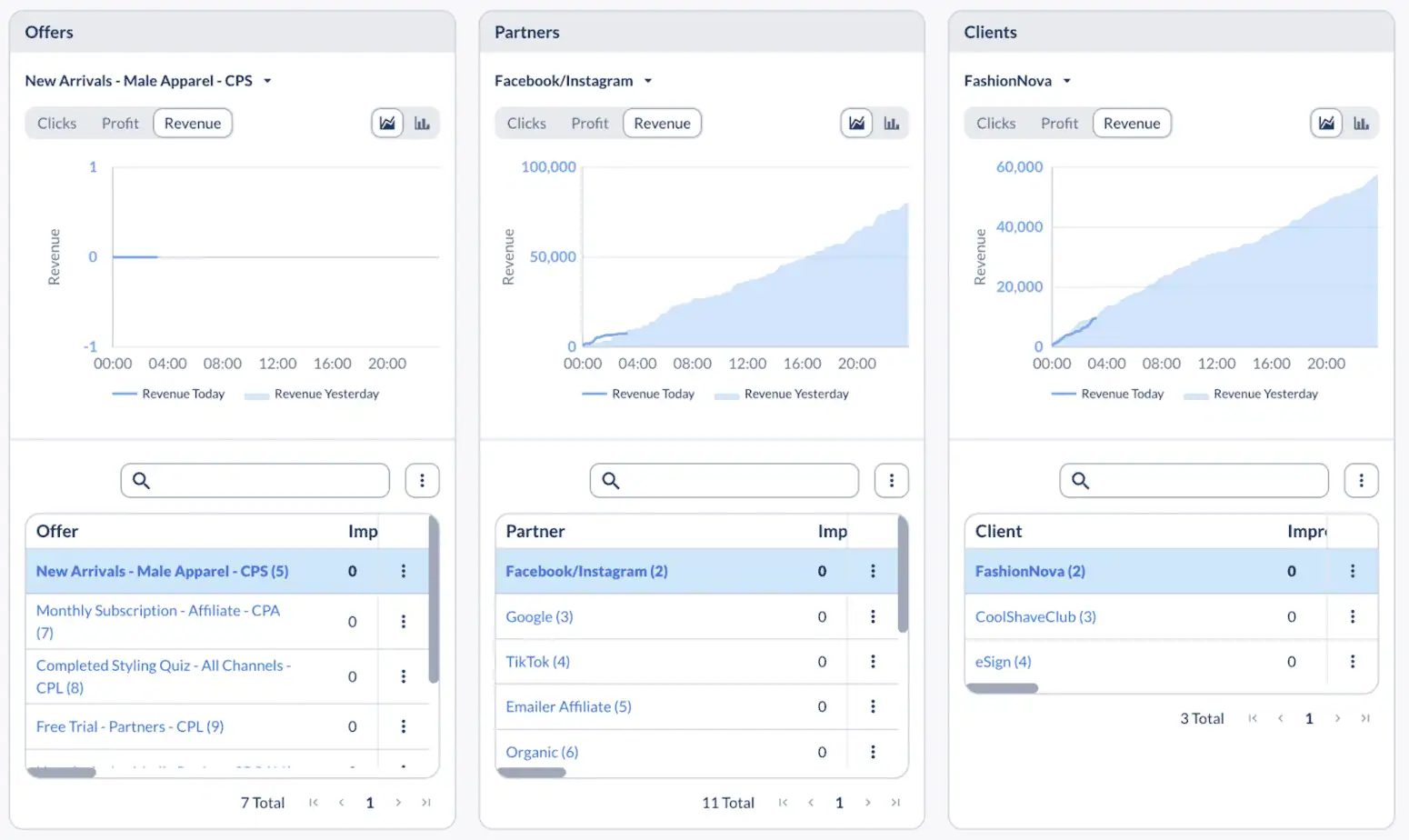
Dashboard showing traffic from outside Everflow’s marketplace.
In short, if you manage multiple partners, channels, or marketing sources and want one clear view of what’s working, Everflow is built for you.
First Impressions & Ease of Use
Everflow’s interface feels modern and clean, and it’s easy to use straight away. You can jump straight into managing affiliates or setting up offers without needing to read complex instructions.
In fact, Everflow has very detailed and easy-to-read guides on how to get set up. These include a lot of dummy data so you can see how a complete dashboard should look once you are set up. I found this really helpful, as it takes away the fear of the blank screen!
Other tools like Impact, PartnerStack, and Upfluence have great dashboards too, but the Everflow dashboard allows you to customize it to see the data that is important to you.
Everflow gives you one view of every channel, affiliates, influencers, media buys, and paid ads all in one place, so you’re not switching between modules like you do in Impact or PartnerStack. Everything updates quickly, and you can filter by offer, partner, or region without leaving the page.
It’s more than a static analytics board. You can monitor performance and spot issues directly from the dashboard. In contrast, tools like Upfluence and PartnerStack are narrower in scope, while Impact’s interface feels a little more complex.
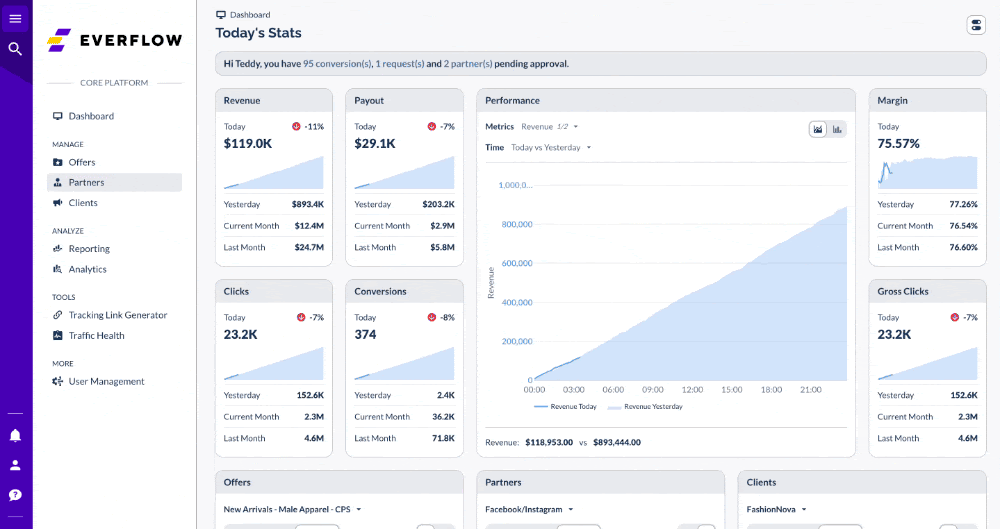
Key Features of Everflow
1. Partner & Affiliate Management
Everflow brings all your partners together, including affiliates, influencers, agencies, and media buyers, into one easy-to-manage hub. You can approve or reject partners manually or using automations, group them by performance, and view every detail of their activity from a single profile.
If you already work with influencers, you can add them directly to Everflow, giving each one their own tracking links, coupon codes, or QR codes for campaigns. This makes it easy to track influencer-driven sales and pay them just like your affiliates, without needing a separate tool.
The Everflow Marketplace is designed to help you find partners such as publishers, ad networks, and media buying teams, rather than individual creators. There are great publishers on there that can help you create viral campaigns, such as Lad Bible, and niche-specific publishers such as Moneywise.
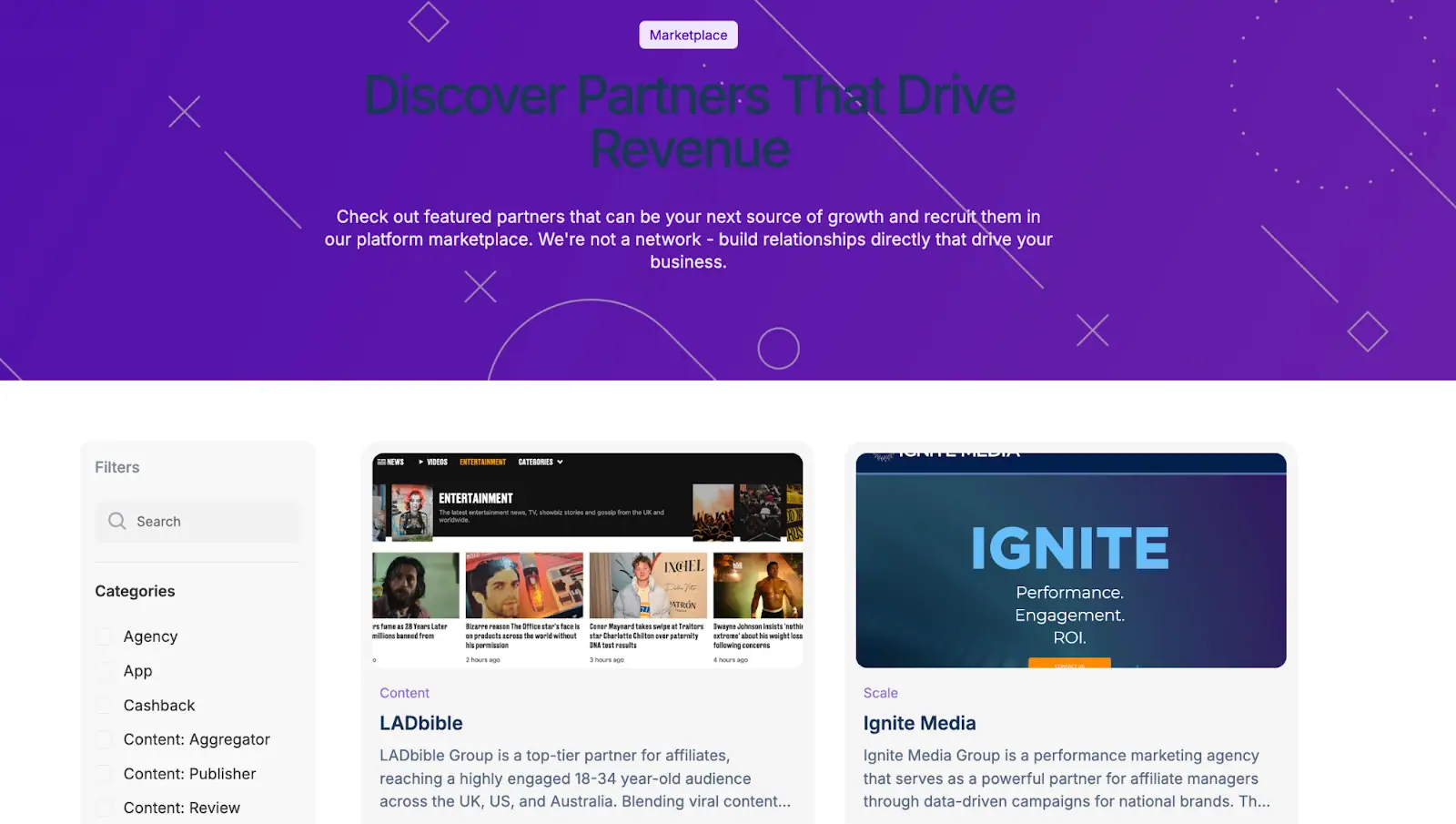
Adding influencers to your tracking is straightforward, and you can assign them different statuses and performance-based incentives using tiers. Each influencer will need their own tracking link, and the tracking link generator does just that.
Once they have been added, they can be tracked in the dashboard like any other partner, plus you can see their performance in detail through their own profile.
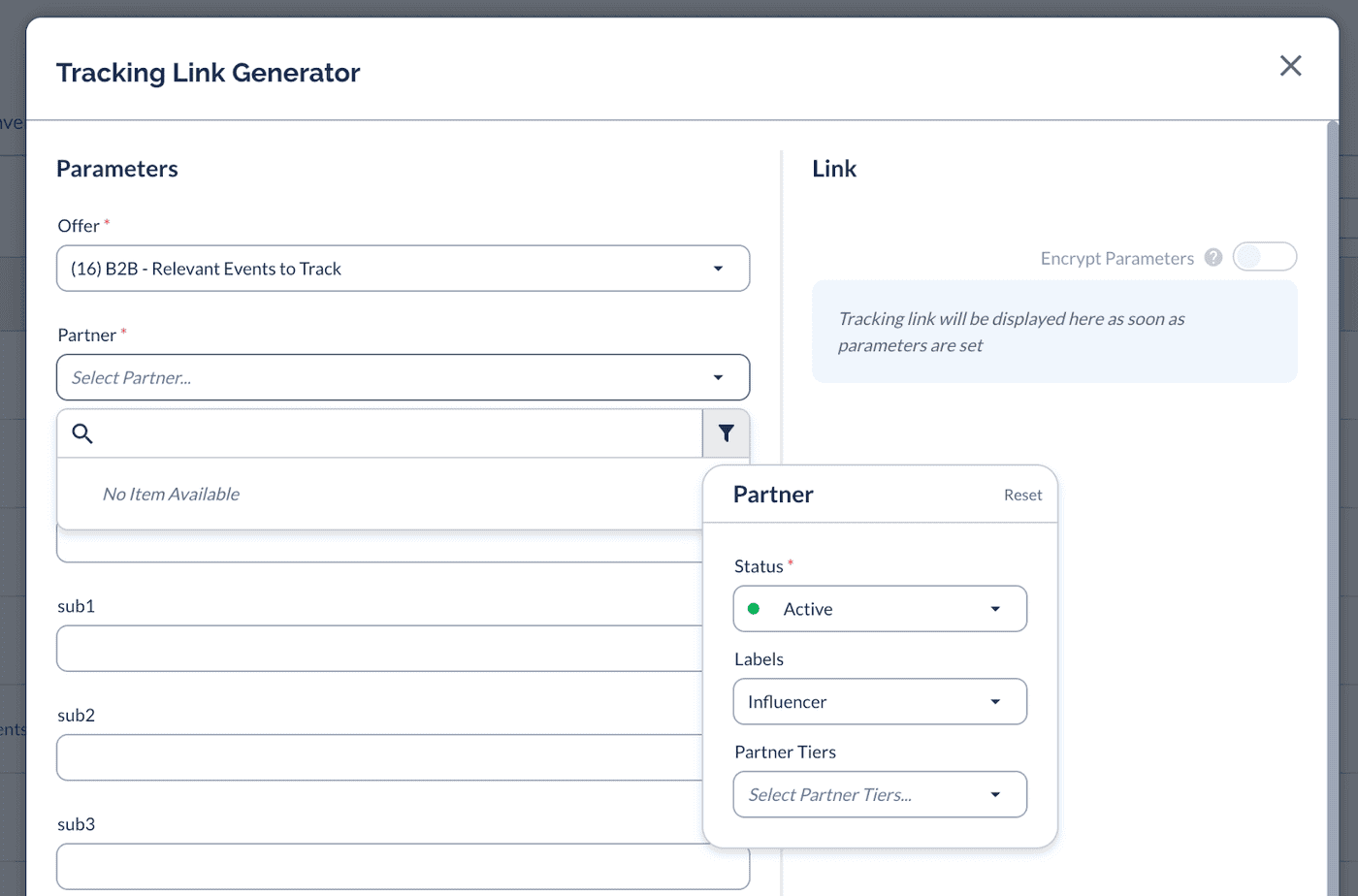
2. Offer & Campaign Management
In Everflow, offers are the campaigns or promotions you create for partners to promote—each with its own tracking links, payout rules, and conversion goals.
Setting up an offer is pretty easy, but there are a lot of details which can be confusing for very new users. You can create campaigns with custom payout types, such as flat fees, revenue shares, or tiered commissions. Once that’s done, you can then attach creatives and assign partners. This makes it easy for the affiliates to promote your company in the best way, using your images and designs.
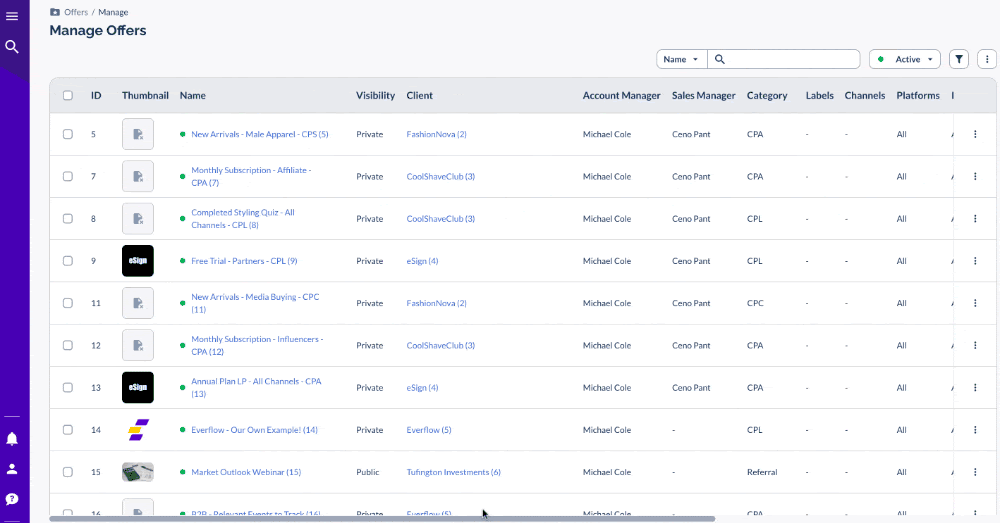
Everything is set up from one screen, and once an offer is live, you can track results in real time.
Where Everflow really starts to shine is in its automation tools, which takes lots of the manual work out of managing campaigns.
- Smart Links automatically redirect each visitor to the most relevant offer, so you’re always maximizing conversions without lifting a finger.
- Fail Traffic ensures that invalid or mismatched clicks don’t go to waste—redirecting them to an eligible offer instead of dropping the user.
- SmartSwitch is Everflow’s optimization engine. It can automatically block placements or partners that underperform, detect potential fraud (like bot traffic or bad proxies), and shift more traffic toward sources delivering high-quality conversions.
- Other automations act like a digital assistant that handles routine tasks—automatically updating offers, sending alerts when metrics change, and syncing data with other tools through scheduled actions, notifications, and webhooks.
You can also create automated alerts and dynamic messages, so your team gets notified the moment something changes—like a sudden spike in invalid clicks or a dip in conversion rates.
Together, these tools make campaign management less about constant monitoring and more like a partner, helping you to grow your business.
I have used a lot of affiliate tools, and the Everflow automations are more comprehensive and powerful than other tools.
3. Tracking & Attribution
Everflow’s tracking suite is seriously impressive and advanced. It lets you track all performance channels, from Google and Facebook Ads to influencers, affiliates, and even offline campaigns (eg, coupon or QR code tracking).
What You Can Track
Everflow, like most tools, tracks three key types of actions (called “Events” in the system):
- Impressions
- Clicks
- Conversion Events – anything measurable after a click, such as purchases, form fills, or demo signups.
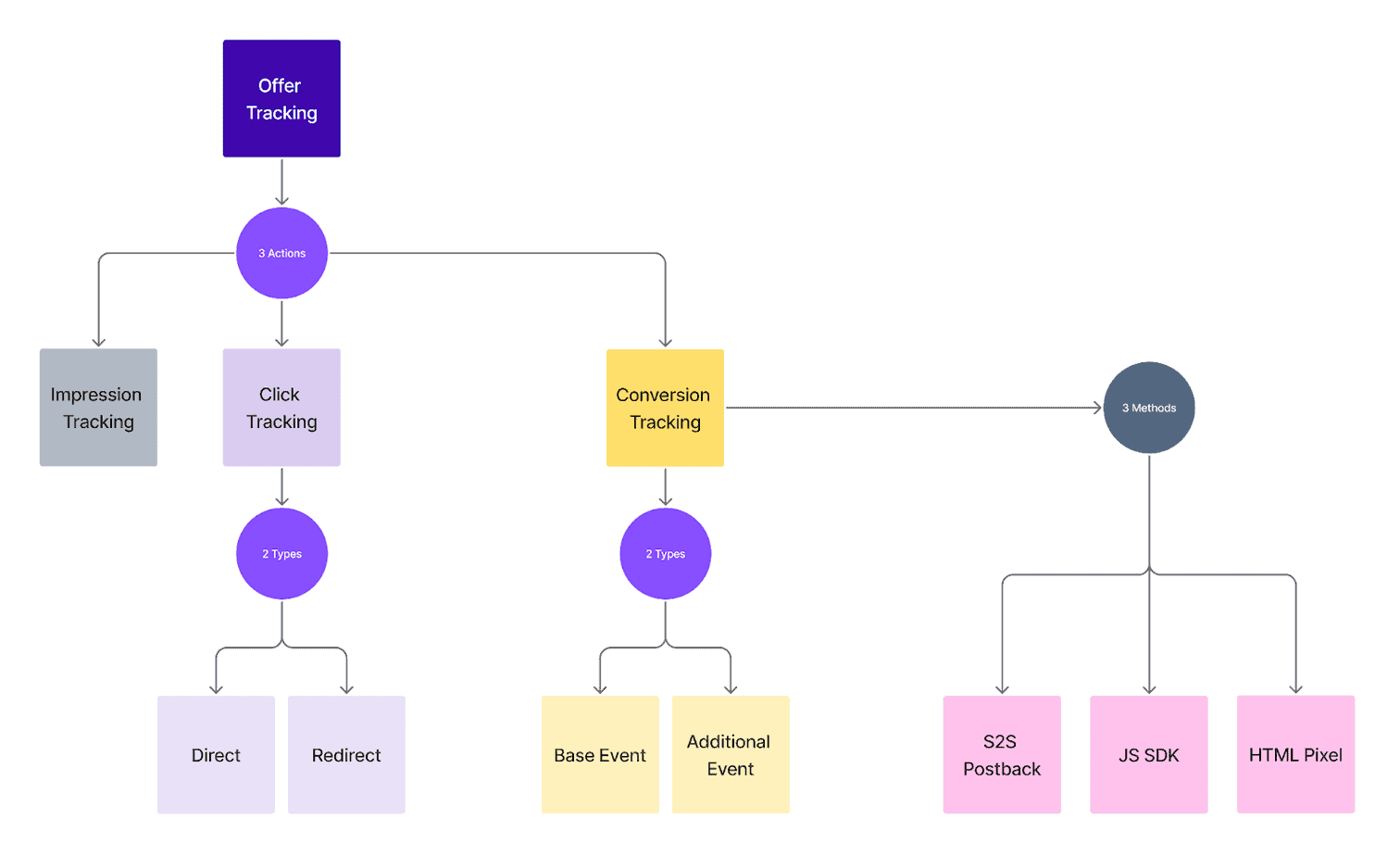
Source: https://helpdesk.everflow.io/customer/introduction-to-tracking-with-everflow
Tracking Links & Clicks
When you create an offer, Everflow generates Tracking Links. These are unique URLs that partners use to send traffic to your campaign. Each time a visitor clicks that link, a “click” event is recorded, along with all relevant data (source, device, region, sub-ID tags, etc.).
I created a tracking link below, so you can see how easy it is to create a basic tracking link, but there are lots of variables if you want to have more complex tracking.
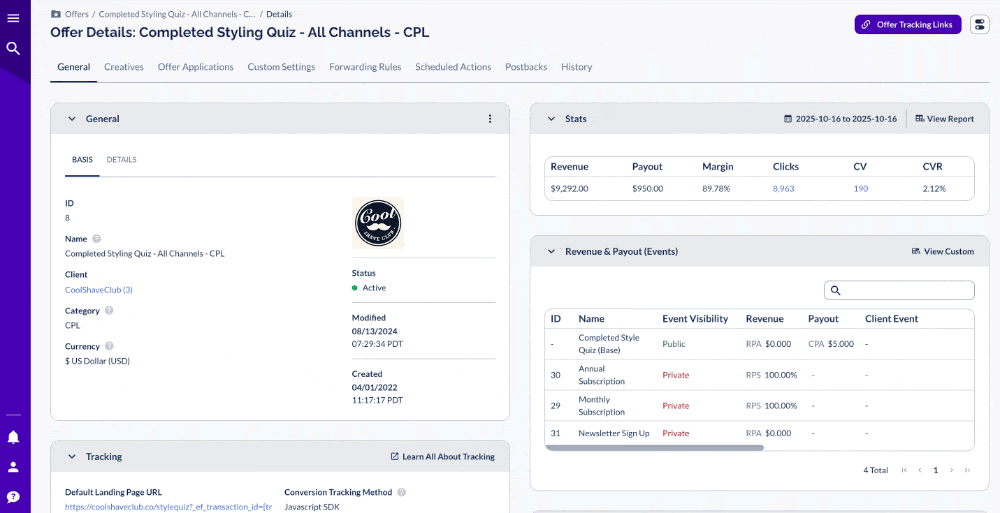
Everflow supports two main types of click tracking:
- Redirect Linking: The most common and reliable method. Each click generates a unique transaction ID to ensure precise attribution. Redirect links have a tracking URL, which some partners don’t like using. But according to Everflow, these types of links are more robust as they don’t require any code being added to your site.
- Direct Linking: Ideal for media buys, social ads, or branded content campaigns where redirects aren’t allowed. Direct links go directly to your website, rather than via an Everflow URL. These require a bit more technical knowledge to set them up.
Conversion Event Tracking
Conversions are the reason you set up the tracking links, and can be used for any kind of conversion, such as a purchase, signup, or app install. Everflow records conversions automatically through your chosen tracking method, linking each conversion back to the original partner and click.
All the conversion events I created appear in the dashboard, so it is super easy to track everything. You can also set up custom conversion events for secondary actions like upsells, renewals, or webinar registrations.
I really liked the flowchart report, which allows you to see where the conversion comes from and the entire customer journey.
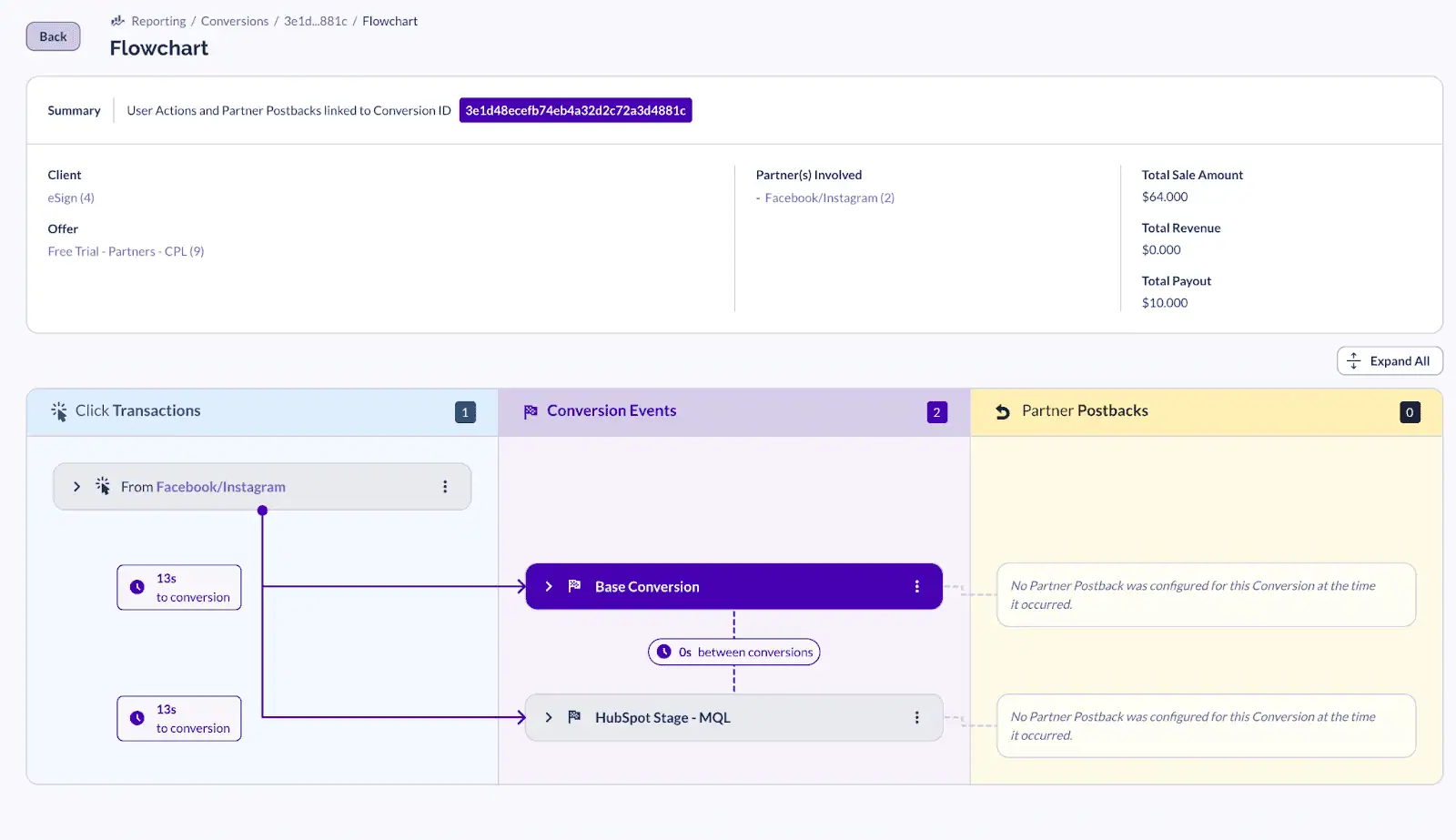
Advanced Attribution Options
Beyond basic tracking, Everflow includes some advanced attribution models:
- Email Attribution: Matches leads or customers by email address, connecting offline or CRM activity back to the original partner.
- View-Through Attribution: Tracks conversions that come from ad impressions, not just clicks.
- First-Touch Attribution: Gives credit to the first partner who introduced a user, fixing the common “coupon site steals credit” issue.
This is different to most other platforms, and these features give you a full-funnel view of every partner’s contribution, something most affiliate platforms can’t provide. These are advanced features that will mostly be used by enterprise-level companies, but it is a good example of how Everflow can grow with your business.
Overall, my impression of the tracking in Everflow was that it is very impressive. The only downside would be it could be quite complicated for people who are very new to tracking affiliates and partners. Having said that, the basic options are very easy to understand, and it is great that the tool can grow with you as your tracking needs increase.
4. Analytics & Reporting
Everflow’s analytics tools are built for data-hungry marketers. You can run:
- Dimensional Reports – view up to five data points at once.
- Flex Reports – pivot table-style reports for slicing and grouping data.
- Placement Reports – analyze traffic quality and catch low-value placements.
You can also run reports on all the different filter options, such as offer, account manager, partner, etc. There are too many options to add here, but you can see them in this link.
This means you can run reports on how a particular brand is doing, or whether an offer is converting, or even how a particular account manager is performing, as I show below.
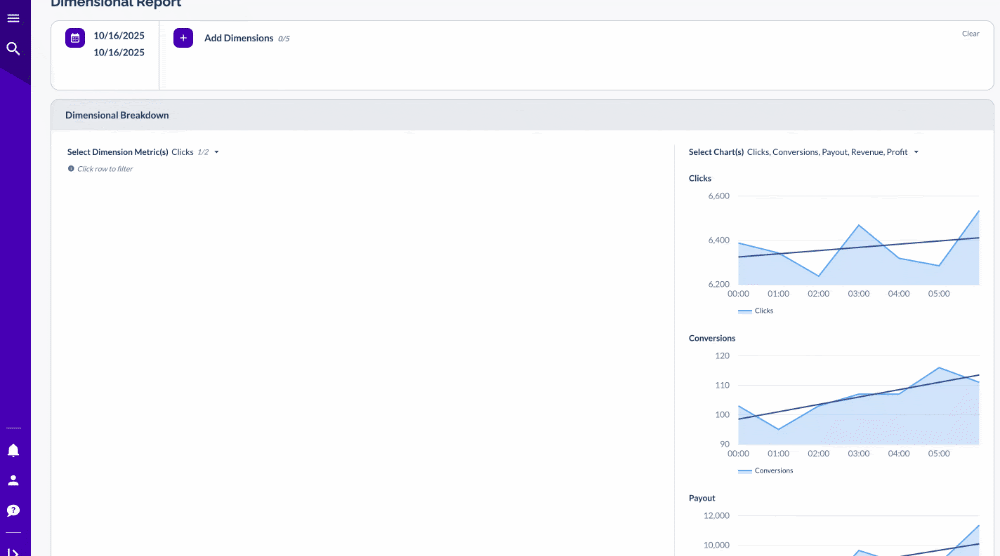
This granular level of detail is perfect for tracking multiple offers, partners, and campaigns. Plus, you can see all the high-level details in the dashboard.
5. Payments
Everflow has their own payment system, called Everflow Pay. It allows you to automate partner payments, invoices, and tax document collection. There’s also Managed Payments, where Everflow handles everything for you for an extra fee.
Setup is quick: partners enter their banking and tax information once, and from there, you can review, approve, and process payments automatically or on schedule.
6. Integrations & Ecosystem
Everflow integrates with all major platforms, including:
- Shopify, WooCommerce, BigCommerce
- HubSpot, Salesforce, Stripe
- Google Ads, Meta (Facebook), TikTok
The main benefit of the integrations is you can see all your data in one place, to help you make good marketing decisions. You can see all your integrations on the dashboard.
Performance
Everflow runs really fast. I didn’t experience any delays at all, and the data is populated from page to page straight away. Reports load instantly, dashboards update in real time, and integrations don’t lag.
I really like how the data in the dashboard is presented; it makes it easy and fast to move from the dashboard to click further into an item for more information. For example, in the dashboard below, I am looking at partners and the number of impressions. If I want to click in to see why YouTube doesn’t have any impressions, I can click in and go into a bit more detail.
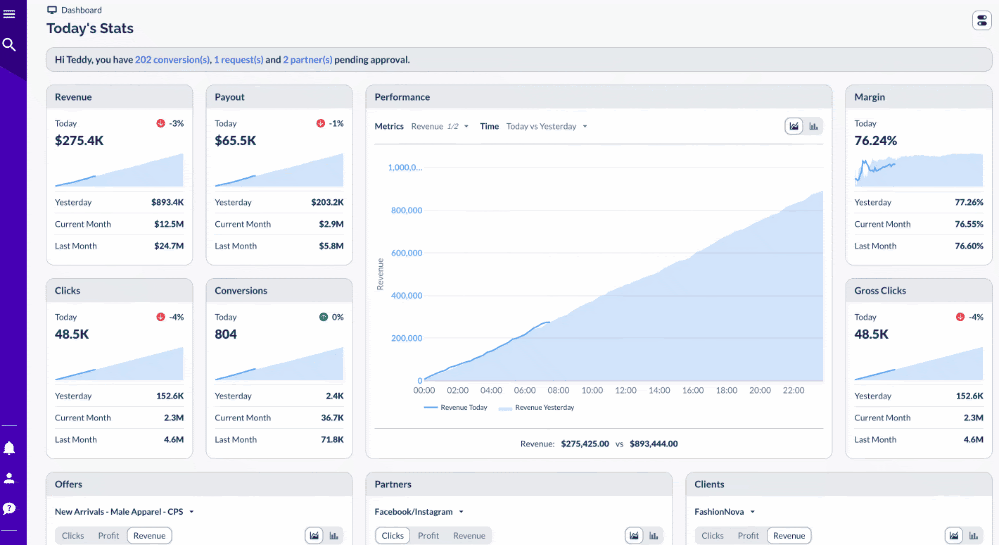
How Everflow Compares for Affiliate Programs
While PartnerStack, Upfluence, and Impact all handle partnerships in their own ways, Everflow gives you more control over tracking, payouts, and data transparency.
Everflow vs PartnerStack
PartnerStack was built for SaaS referral and reseller programs, not traditional affiliates. It’s great at automating partner onboarding and payouts, but it’s limited in tracking flexibility.
Everflow, on the other hand, lets you manage affiliates, influencers, and even media buyers side by side. You can customize attribution models (first-touch, multi-touch, view-through), create unique offers, and run campaigns outside SaaS referrals.
Everflow vs Upfluence
Upfluence is an excellent influencer discovery and outreach tool, but it more or less stops there. You can’t track clicks, conversions, or multi-channel revenue from outside influencer campaigns without exporting data elsewhere.
Everflow doesn’t help you find influencers as such, but once you’ve recruited them, it’s far better at tracking and paying them. Each influencer gets a unique link or coupon code, and you can view performance data right alongside your affiliate and media campaigns.
Everflow vs Impact
Impact is the heavyweight in enterprise partner management. It’s powerful, but it’s also complex. Onboarding takes time, and running smaller affiliate programs can feel like overkill. Plus, it is expensive.
Everflow offers similar tracking accuracy and integration depth but with faster setup and a much easier UI. You get advanced automation and real-time analytics.
Pros and Cons
Pros
- Fantastic unified dashboard for affiliates, influencers, and agencies
- Granular multi-touch attribution (click, view, email, first-touch)
- Automation that reduces manual work
- Built-in payments and fraud protection
- Fast, reliable analytics with flexible reporting
Cons
- Pricing not publicly listed
- Advanced features require some knowledge and setup (though the basic functions are easy to use)
- May be overkill for small businesses
Pricing & Support
Everflow offers tiered pricing based on usage, and an optional premium service, Everflow Plus, which includes a dedicated account manager, quarterly reviews, and affiliate readiness training. Whilst their pricing isn’t public, it is tiered, so it grows with you as your payouts grow too.
The customer documentation is really top class, one of the best I have seen in any business. The search function for different features is easy to use and picks up what you are looking for, even with typos or misunderstandings. I have linked to some of the help articles in this review, so you can check it out for yourself.
They also have an AI assistant, which answered nearly all my questions. Plus it was easy to get through to an actual agent, if you need to talk to a real person!
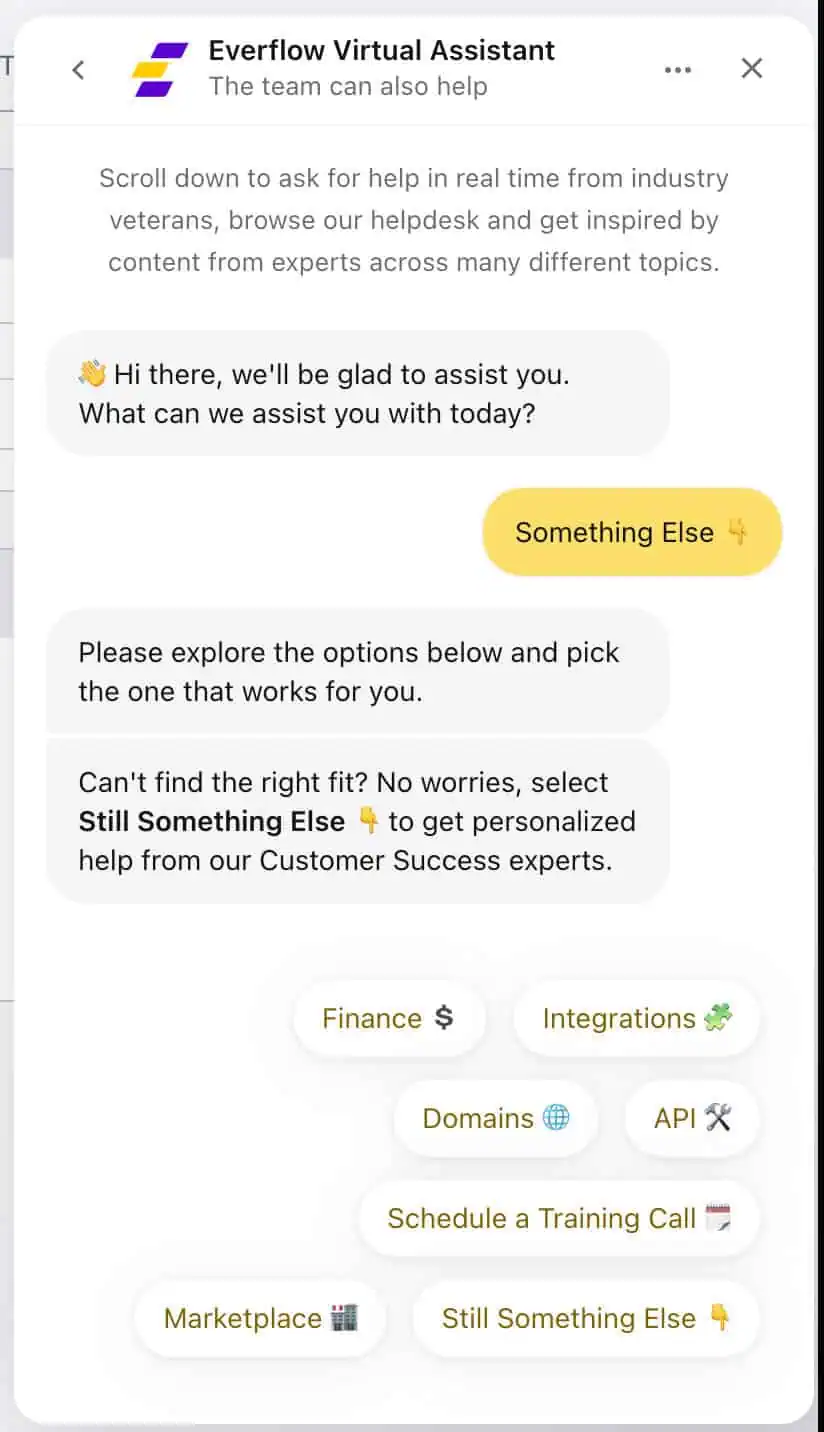
Final Verdict
After testing Everflow, I’d call it one of the most complete partner marketing platforms on the market. It’s flexible enough for eCommerce and SaaS, smart enough for agencies, and scalable enough for enterprise teams.
If you’re ready to stop guessing which partners are driving revenue and you want automation, tracking, and reporting that actually save time, then Everflow is a winner.
In short: Everflow isn’t just for affiliates. It’s the command center for every type of partnership you manage in 2025.

